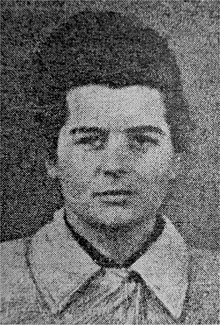This article needs additional citations for verification. (November 2014) |
Else Lieschen Frida "Elsa" Ehrich (8 March 1914 – 26 October 1948) was a convicted war criminal who served as a Schutzstaffel (SS) guard in Nazi concentration camps, including at Kraków-Płaszów and the Majdanek concentration camp during World War II. She was tried in Lublin, Poland at the Majdanek Trials and sentenced to death for war crimes. Ehrich was hanged on 26 October 1948.[1]
Elsa Ehrich | |
|---|---|
 Elsa Ehrich at the Majdanek Trials, 1946 | |
| Born | 8 March 1914 |
| Died | 26 October 1948 (aged 34) |
| Cause of death | Execution by hanging |
| Nationality | German |
| Occupation | Camp guard |
| Employer | SS |
| Political party | Nazi Party |
| Criminal status | Executed |
| Conviction(s) | Crimes against humanity |
| Trial | Majdanek trials |
| Criminal penalty | Death |
She was an Oberaufseherin at Majdanek, and took active part in all the major selections to the gas chambers and executions. She maltreated prisoners, including children. Her assistant was Hermine Braunsteiner, who was later denaturalized and deported from the United States back to Germany.[2]
Background edit
Ehrich was born in Bredereiche. She worked in a slaughterhouse. On 15 August 1940, she volunteered for service in the concentration camp Ravensbrück as an SS guard. From 1941, Ehrich worked as a SS-Rapportführerin (Rapport Leader). In October 1942, she was transferred to Majdanek near Lublin, where after some time she was promoted to SS-Oberaufseherin. She was under the SS command in the camp. Ehrich is believed responsible for the death of thousands of prisoners (including in gas chambers), from the women's section of the camp with children.
During the 34 months of camp operation, more than 79,000 prisoners were murdered at the main camp alone (59,000 of them Polish Jews) and between 95,000 and 130,000 people in the entire Majdanek system of subcamps.[3]
On 3 November 1943, around 18,000 Jews were killed at Majdanek during the largest single-day, single-camp massacre of the Holocaust,[4] named Harvest Festival (totaling 43,000 with 2 subcamps).[5]
In February 1943, Ehrich became ill due to typhoid. On 5 April 1944, she was the Oberaufseherin in the Kraków-Płaszów concentration camp, and from June 1944 to April 1945, she was assigned to Neuengamme. After the war, in May 1945, she was arrested by British occupation authorities in Hamburg, who transferred her to U.S. custody in the camp for war criminals PWE29 in Dachau, where she shared the cell with Maria Mandl. She was transferred to the Polish authorities. In 1948, she stood before the District Court of Lublin at the second Majdanek Trials, accused of committing war crimes and crimes against humanity.
Ehrich was found guilty of the allegations and on 10 June 1948, was condemned to death by hanging. After the announcement of the judgment, she asked Polish President Bolesław Bierut for clemency, on the grounds that she had a small son and wanted to atone for her guilt. President Bierut rejected the request. Ehrich was executed on 26 October 1948 in Lublin Prison. [citation needed]
References edit
- ^ "Wykaz sądzonych członków załogi KL Lublin (Defendants at the KL Lublin Majdanek Trial)". Procesy zbrodniarzy (Trials of war crime perpetrators). KL Lublin. Archived from the original on 14 October 2013. Retrieved 15 April 2013.
- ^ Friedlander, Henry; Earlean M. McCarrick. "The Extradition of Nazi Criminals: Ryan, Artukovic, and Demjanjuk". Annual 4 Chapter 2 Part 1. Museum of Tolerance (Simon Wiesenthal Center Multimedia Learning Center). Archived from the original on 8 February 2012. Retrieved 9 December 2020.
- ^ Reszka, Paweł (23 December 2005). "Majdanek Victims Enumerated. Changes in the history textbooks?". Gazeta Wyborcza. Auschwitz-Birkenau State Museum. Archived from the original on 6 November 2011. Retrieved 13 April 2010.
- ^ USHMM (11 May 2012). "Soviet forces liberate Majdanek". Lublin/Majdanek: Chronology. United States Holocaust Memorial Museum, Washington, D.C. Retrieved 13 April 2013.
- ^ Jennifer Rosenberg. "Aktion Erntefest". 20th Century History. About.com Education. Archived from the original on 27 December 2016. Retrieved 16 April 2013.
External links edit
- Frauenkonzetrationslager, KL Lublin/Majdanek homepage; accessed 13 November 2014.
- Silke Schäfer, Zum Selbstverständnis im Konzentrationslager. Das Lager Ravensbrück, Berlin, 2002. Thesis; accessed 13 November 2014.